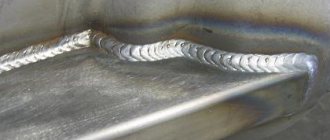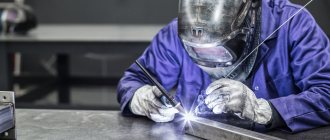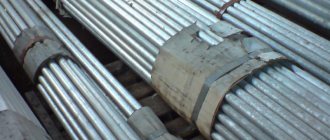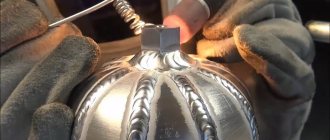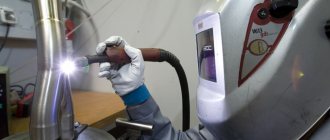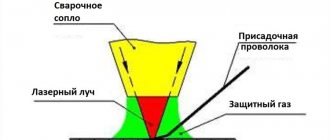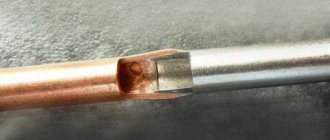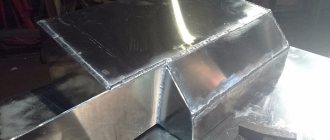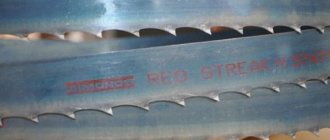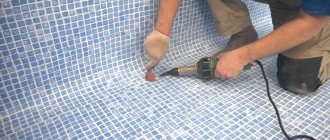Features of aluminum welding
This metal is very capricious when welding due to its physical and chemical properties. Its surface is covered with an oxide film even at room temperature. On the one hand, this is even good, because the oxidized layer protects the material from corrosion. But if you try to weld it just like steel, for example, you may run into a big problem.
The melting point of the oxide on the surface of an aluminum billet is about 2000 °C, while the material itself melts at about 600 degrees Celsius. Welding in the usual way will lead to the fact that the filler material will simply be laid on the surface, preventing the proper quality of the weld. An increase in amperage will cause burnouts. In this case, the weld pool will rapidly oxidize.
Aluminum when welding:
- Crystallizes quickly.
Hardening occurs after cooling by only 15-20 °C. - Incredibly fluid.
When molten, it resembles water, which makes it difficult to weld if the surface of the product is inclined. It is also this property that increases the risk of through burns during manipulation. - Retains color after melting.
For this reason, it is more difficult to control the state of the weld pool and calculate the required amount of filler material. - Evaporates hydrogen.
This occurs due to contact with the atmosphere. As a result, pores are formed in the suture structure, which make the joint more fragile. - Characterized by increased shrinkage.
There is a possibility that, upon cooling, the weld beads will sag more than necessary. You will have to additionally weld the craters in the seam.
To achieve the desired effect, it is enough to block the access of ambient air to the melting zone. For this purpose, inert gas media are used.
Features of semi-automatic aluminum welding
There are several reasons that forced engineers to develop welding equipment taking into account the peculiar properties of aluminum, among them:
- increased thermal conductivity, 5-6 times higher than that of steel;
- fast-forming, inconspicuous oxide film with high density and high melting point;
- low melting point;
- formation of a crater at the end of the seam.
A modern semi-automatic aluminum welding machine allows you to overcome the difficulties of work. This is achieved by special parameters of welding equipment.
- The high thermal conductivity of aluminum requires a maximum welding current of the machine of at least 200-500 A.
- High-quality welding is performed using pulsed current. The high-voltage pulse destroys the oxide film, and in the rated voltage mode a weld pool is formed. This mode also reduces splashing. Cheap welding machines operating on direct current produce low-quality seams.
- A wide range of welding current adjustments does not allow raising the welding temperature so much that metal burns will form.
- A special software function that correctly completes the weld without creating a crater.
- Increased wire feeding speed with four rollers with Teflon liner. This will prevent the wire from curling into rings.
Devices that support such functions and parameters provide professional quality welding.
Pros and cons of semi-automatic aluminum welding
Before choosing a welding machine for aluminum welding, you need to weigh the positive and negative aspects of the technology. After this, decisions can be made.
| pros | Minuses |
| relatively low price | mandatory use of gas |
| availability of consumables on the market | difficulty in selecting wire thickness when working with materials of uncertain composition |
| quick preparation for work and high speed of the process | |
| versatility, works with different metals |
Voting for the best aluminum welding machine
Which aluminum welding machine would you choose or recommend?
Svarog PRO TIG 200 P DSP AC/DC E201 00000092681
33.33 % ( 2 )
TCC TOP TIG/MMA-315P AC/DC 018095
16.67 % ( 1 )
Aurora STRONGHOLD 315M 17836
0.00 % ( 0 )
START PRO WEGA model TIG 205 AC/DC PULSE 3W205AP
33.33 % ( 2 )
QUATTRO ELEMENTI Multi Pro 2100 772-593
0.00 % ( 0 )
BRIMA TIG-180A
0.00 % ( 0 )
WERT MMA SWI 190 187150
0.00 % ( 0 )
Multi Pro 1700 165A QUATTRO ELEMENTI 790-052
16.67 % ( 1 )
Elitech MMA IS 220N
0.00 % ( 0 )
Functionality of welding machines
Manufacturers are constantly improving semi-automatic welding machines for welding aluminum alloys. The result is a variety of modes and additional features that enhance the quality. Of course, the price also increases.
In order not to overpay for unnecessary functions, you need to understand why they are needed. Perhaps this is just a marketing ploy by the manufacturer.
MIGPulse is one of the most common and universal welding methods with non-contact transfer of a drop from the electrode to the weld pool. In this mode, the electrode never touches the bath. One drop is formed in one pulse and is transferred by the arc to the welding zone. The process of metal fusion occurs during its cooling in the background phase of applying voltage between pulses. This mode allows you to reduce the wire feed speed. Welding speed and arc power are controlled by the height and width of the peaks and the distance between them. The mode does not create splashes and reduces the risk of cold rubbing.
DoublePulse MIG - in this mode, the pulse current has two levels. The high phase drives the drop into the melt zone. In the low phase of the pulse, the metal is welded and cooled. The operator can adjust the level of the pulse pads and adjust the length of each pulse. It fully controls the shape and amplitude of the voltage and can perfectly select the welding mode.
The S4T mode allows you to control the burner. If the machine has a “Quick Start” function, which is activated by pressing the torch trigger, the operator can start welding aluminum without preheating - cold. After releasing the trigger, the welding current is reduced to operating current.
DownSlope - ensures crater welding at the end of the seam, smoothly reducing the welding current.
Adjusting the arc inductance reduces spatter and improves connection quality. Varies depending on the thickness of the wire.
Digital control significantly reduces the time for setting welding parameters. Thanks to synergic control, almost all welding parameters are set automatically. The operator is only required to indicate the thickness of the wire and the type of metal. The computer has several welding programs in memory, which allows you to instantly set the ideal operating mode.
The 4-roller mechanism ensures smooth wire drawing. Unlike welding machines for ferrous metals, where it is enough to have a 2-roller filler material supply system, in a semi-automatic machine for welding aluminum alloys it is necessary to use only a 4-roller mechanism. This is due to the fact that the wire for welding aluminum is not hard and soft and can get tangled, forming rings. Therefore, it requires a more complex feed system with tension adjustments and Teflon channels.
Review of popular models
The industry offers a lot of semi-automatic welding machines. The review describes three popular models, sorted from simple and cheap to complex and expensive.
VEGAMIG 180/2 TURBO
A household welding machine operating from a single-phase network in MIG/MAG mode, designed for welding aluminum, ferrous metals and stainless steel in an argon environment. The unit creates a welding current in the range from 30A to 170A with a power consumption of 5.2 kW.
Although the device is considered a household device, not every apartment has wiring that can withstand a load with a current of 23A. Therefore, before turning on the device, pay attention to what current strength the network in your home, garage or workshop is designed for.
The semi-automatic welding machine VEGAMIG 180/2 TURBO for aluminum supports the use of wire with a diameter of 0.8-1 mm and can weld sheets up to 2 mm thick. The arc is formed by direct current.
Equipped with two step regulators:
- current strength;
- wire feed speed.
There are no automatic adjustments, therefore, when working with the device, the welder should rely only on his knowledge and experience.
When choosing a welder, pay attention to the protection class. VEGAMIG 180/2 TURBO is classified as IP21, which means that it cannot be used outdoors.
PICOMIG 180 PULS
Mobile inverter semi-automatic MIG/MAG welding machine, supporting pulse welding mode. In total, the device supports four types of welding at a professional level:
- MiG/MAG;
- MiG/MAG PULS;
- MMA;
- TiG DC.
The device is powered by a single-phase network, consumes 6.4 kVA and supports a maximum welding current of 170A.
The unit is equipped with an automatic adjustment system, an electronic control unit and a digital display.
The device comes with a minimum set of “readytoweld” accessories.
SPEAKER ALUMIG 300 P DpulseSynegric
The universal welding machine operates in semi-automatic MIG/MAG and manual MMA arc welding modes. Thanks to a wide range of workflow settings, the unit welds not only aluminum, but also non-ferrous and ferrous metals, stainless and galvanized steel.
The device is powered by a three-phase network and can create a maximum welding current in the following modes: MIG - 300A and MMA - 250A. This is enough to ensure high-quality work in industrial environments. The device can be used wherever the electrical network can provide a power of 10.60 kVa.
The device has a number of useful functions, including:
- MIGPulse;
- DoublePulse MIG
- S4T mode;
- fast start;
- DownSlope
- and etc.
The welding machine is equipped with a computer with digital display for synergic control. The memory stores 10 programs of the most frequently used processes. The transition from one type of welding to another takes a few seconds. Synergic control automatically sets the current strength, frequency and pulse shape depending on the thickness of the wire and the type of metal.
Semi-automatic pulsed MIG/MAG welding: what is it and how does it work?
Technologies for plastically joining metal elements are constantly evolving. New methods and methods for thermally bonding materials are emerging. Pulse welding is used for the installation of supporting structures, when laying pipelines, in industrial and civil construction at all stages of construction. Semiautomatic machines are used in production and at home, in large enterprises and small workshops.
What is MIG welding?
This is a method of non-contact transfer of filler metal into a joint to produce a uniform joint. The welding wire, heated by the electric arc, melts, and the metal flows drop by drop into the melt pool. Thanks to the high-frequency characteristic of the welding current, the heat input can be varied with minimal spatter. This is the main difference between the technology and the jet and large-droplet transfer of additives characteristic of other types of welding.
With pulsed power supply, the drop is pushed into the working area due to frequent changes in arc density.
From a physical point of view, pulsed welding technology is a multi-stage process. When power is supplied, an electric arc occurs and flares up due to the potential difference. The rod begins to heat up and a small drop forms. When it is separated from the tip of the wire, it moves to the surface of the workpiece being welded. After penetration, the diffusion layer crystallizes. When moving the semi-automatic device, cyclic repetition of operations occurs. A uniform seam bead is formed at the joint.
Advantages of semi-automatic machines
Filler wire feed machines are often equipped with semiconductor converters to provide pulsed power. The functionality of such power supplies is much higher than that of generators and rectifiers. When you need a perfect weld seam, a sealed, reliable connection, it is better to choose inverters with a high-frequency AC conversion function.
Although the cost of semi-automatic MIG/MAG welders is higher than that of other welders, the one-time investment quickly pays off by reducing the cost of the process of obtaining permanent connections. A few words should be said about the advantages of such equipment.
- Saving on consumables. MIG welders are more universal; when using a filler rod of a certain diameter, by adjusting the rotation speed of the rollers, they form rollers of the required thickness. There is no need to constantly change coils to perform different tasks. A rod with a thickness of 1.1 mm can replace wire with a diameter of 0.9 mm and 1.3 mm. In other words, you won’t have to waste time replacing consumables. As a result, non-productive costs are significantly reduced and labor productivity increases. The cost item for the purchase, storage and transportation of auxiliary materials is sequestered. Instead of two or three different coils, the welder only needs one.
- Small spatter area, low smoke generation when welding non-ferrous metals. MIG semi-automatic machines are often used for the manufacture of products from alloyed metals and non-ferrous materials. Non-ferrous metals burn out when heated. When the heating time interval in the process of joining workpieces is reduced, the metal does not have time to deform, and smoking is limited. Compared to traditional welding equipment, pulse modifications have the advantage of low spatter. Due to the specific shape of the arc, wetting is ensured when a drop falls. Metal losses are minimized and the additive is used more efficiently. Workwear burns out less, there is no need to fence off the work area, and the risk of fire from accidental sparks is reduced. It is easier for the welder to control the welding area. Another plus is that the seams do not need to be thoroughly cleaned; abrasives and steel brushes are not wasted on cleaning the surface.
- Controlled heat input. This property is relevant when working with thin sheet materials, long and shaped products. Pulse welding is characterized by low heating. In the thermally affected zone, semi-finished products do not have time to deform, the tendency of finished products to crack is reduced, and the percentage of defects is lower. Semi-automatic machines are optimal equipment for stainless steel, nickel, copper and aluminum alloys, duralumin, which are characterized by high sensitivity to thermal effects.
Comparison of pulse welding with other methods
Unlike other technologies, MIG welding is not characterized by cold welds. The method is much more effective and economical than large-droplet or jet methods. When transferring metal through short circuits, the melt splashes heavily. Although the workpieces do not have time to warm up strongly, the seams are leaky and uneven.
When transferring large droplets, it is difficult to control the thickness of the formed roller; consumables quickly run out. Coils often have to be changed. When welding thick-walled semi-finished products, large drops are more convenient and fill the melt pool faster. But when they fall, they are able to stretch out and “stick,” causing the arc to burn out. Another disadvantage is that a large heat input is required to melt the additive. Although, in terms of the speed of seam formation, the large-drop method is ahead of the pulse method. From an economic and aesthetic point of view, the second method is preferable.
Jet transfer is characterized by a rigid current-voltage characteristic. Despite the productivity of surfacing and greater penetration depth, the pulse technology is more functional in terms of the number of available spatial positions. In addition, during jet transfer, due to the high heat input, there is a high probability of burns.
Connecting and setting up the device
When generating a pulse, a reliable ground connection is necessary. For connection, it is better to purchase a double-insulated power cable. The optimal length is up to 15 meters. With less, the inductance increases. It is forbidden to wind pieces of wire around conductive elements; as the induction increases, the pulses are smoothed out.
Much attention is paid to customization. The quality of the final product depends on this. It is important to ensure that all pieces of equipment are connected correctly. By adjusting the shape of the pulse wave, an aesthetic connection is achieved.
- The current is minimal, but sufficient to maintain the arc;
- The current increases;
- The current strength is maximum, the oxide film is destroyed, the drop comes off the electrode;
- The current strength drops. The weld pool cools down.
Waveform Settings
There are only four wave formats:
- the classic sinusoid forms a soft, wide, moderately noisy electric arc with shallow penetration of a large area;
- the rectangular curve ensures stable combustion and is characterized by deep penetration even with fast penetration;
- rounded rectangular allows you to control the size of the melt pools, forms a smooth, slightly flat arc, relevant when working with thin-walled semi-finished products;
- triangular - the most effective, reduces the degree of deformation of the weld due to minimal heating at the electric current peak load.
The waveform is adjusted according to the instructions included with each semi-automatic machine. Some models have the ability to adjust the curve. You can individually adjust the ampere characteristics, based on the characteristics of the filler rod and specific conditions.
A semiconductor power source is capable of generating a wave of a given geometry. You can also adjust the dynamics of changes in wave height and width. This approach improves the quality of seam beads and makes it possible to obtain homogeneous joints without deformation of the heat-affected zone. The droplet formation process is also optimized; as the wave decreases, it is possible to achieve optimal wetting when transferring metal.
Devices with an output curve control function are equipped with sets of preset settings. The welder has the ability to control the rate of increase or decrease of the electric wave, the duration of the peak, achieving the desired wave geometry.
Other recommendations
Difficulties arise when thermally joining thin-walled metal products with direct current of reverse polarity. In this case, the electrode is connected to the positive terminal, the minus is connected to ground. Changing the poles allows you to shift the area of maximum heating to the tip of the wire, it melts faster, and droplet formation increases. The parts being connected warm up much more slowly.
The pulse mode setting is limited in any case. Completely depends on the capabilities of the welder. Modern inverter models provide for synergy - the interdependence of the main parameters and their mutual influence on each other. All current characteristics parameters are selected automatically when the amperage or voltage changes. Professionals prefer to use manual settings. During the work, depending on the type of metal being welded and the format of semi-finished products, experienced welders regulate:
- The frequency or dynamic change of the pulse achieves the transfer of the optimal number of melt drops per unit time. By increasing the frequency, the frequency of drop formation and welding speed increase. The seam rollers are voluminous.
- Arc height. By changing the distance from the tip of the filler wire to the melt pool, metal transfer is optimized according to the speed regime. With high-frequency pulse technology, the arc length increases, and with a decrease in frequency, it decreases.
Correct setting allows you to achieve high-quality connection of parts and eliminate lack of penetration and other defects. You can get a beautiful seam shape.
Advantages of the pulse mode when welding aluminum
The use of MIG technology reduces the heating of workpieces and significantly reduces the risk of warping of the welded structure. With certain skills, you can weld thin rolled products without burns and obtain finely flaky seams. The finished products will have a good presentation.
Pulse-based technology avoids suture bead defects. When the feed speed of the wire additive is slowed down, the electric arc is quickly ignited. With stable combustion, the speed limit can be normalized.
After crystallization of the melt pool, no final crater is formed. By reducing the operating current values, it is possible to smooth out the shrinkage cavities; they are filled with liquid metal until solidification, without shrinkage.
The main problem when welding aluminum remains the high porosity of the joint. They reduce the strength of seams for bending and torsion, and there is a high probability of depressurization when welding round and profiled pipes. When a pulsed current is applied, the molten metal is constantly mixed, gas vapors are removed, and the connection becomes homogeneous. By changing the frequency and amplitude, you can control the penetration depth. This is especially true when welding thin workpieces.
Equipment selection
Manufacturers offer professional and household equipment for pulsed MIG welding. You can find devices operating on single-phase 220 V and three-phase voltage 380 V, with a welding current power of up to 400 A.
All inverters have a similar operating principle, they differ in current-voltage characteristics, and there are modifications with hard and soft current-voltage characteristics.
For beginners, inverters with synergetic control are preferable. When the welder changes the additive supply speed, the control unit automatically adjusts the waveform and frequency of the working electric current. The electronics eliminate the need for manual adjustments, adjust to the speed of additive release, and immediately respond to changes in the angle of inclination of the burner nozzle. When there is no experience, this model allows you to achieve good results.
Some modifications of modern semi-automatic machines for MIG welding operate in several modes:
- “Pulse” with classic wave settings;
- “Double pulse” with control of metal transfer, the ability to adjust the main parameters of the second pulse. You can change the frequency indicator of the device, set the required value of the lower amperage of the base electric current.
When welding thick-walled workpieces made of non-ferrous and ferrous metals, the semi-automatic MIG/MAG torch gets very hot. For large volumes of work, models with liquid cooling or a large nozzle are recommended to allow for air exchange.
You can find semi-automatic heads with the function of quickly switching wire ejection speeds. The range of application of the device is expanding. It is important to make sure that the consumable is compatible with the inverter model.
Arc force, anti-sticking and hot start are available on almost all inverters. When working at a long distance from the power source, it is advisable to control the operating voltage. The parameter between the output connectors is determined. AC-Waveform is a function for selecting the waveform of alternating current. Manufacturers are usually limited to a maximum of 2 waveforms, but to accurately connect small semi-finished products, it is important to vary the shape of the output curve.
When purchasing welding equipment for auto body repair shops and small workshops, operating conditions, switching dynamics, and intensity of operation must be taken into account. What matters is the thickness of the workpiece and the chemical composition of the alloy being processed.
Conclusion
When choosing a semi-automatic welding machine for aluminum, you should understand exactly what you need it for. It’s one thing when you need to weld something at the dacha and another thing when you provide welding services or start production. Welding machines are not cheap, so choose the best option, taking into account:
- welding current strength;
- presence of synergetic management;
- versatility and the possibility of manual welding;
- protection class;
- completeness;
- presence of software functions and settings memory for different processes;
- price.
You should also make sure that your electrical network supports the power consumption of the device you are purchasing.
If you are interested in the topic of semi-automatic aluminum welding, express your opinion, offer ideas or argue with the author in the comments block. This is interesting.
Advantages of mechanized gas-shielded gas welding
Properly organized semi-automatic aluminum welding provides a number of advantages:
- High performance. Compared to argon arc welding, the MIG process is 3 times faster.
- Easy to use. Unlike the argon arc welding method, even a novice welder can quickly master the semi-automatic welding method. In this regard, making welded joints of aluminum parts with your own hands is popular among amateurs.
- Equipping the semi-automatic machine with a pulse mode allows you to achieve high quality welds and accuracy of geometric dimensions. This minimizes wire losses due to spattering.
